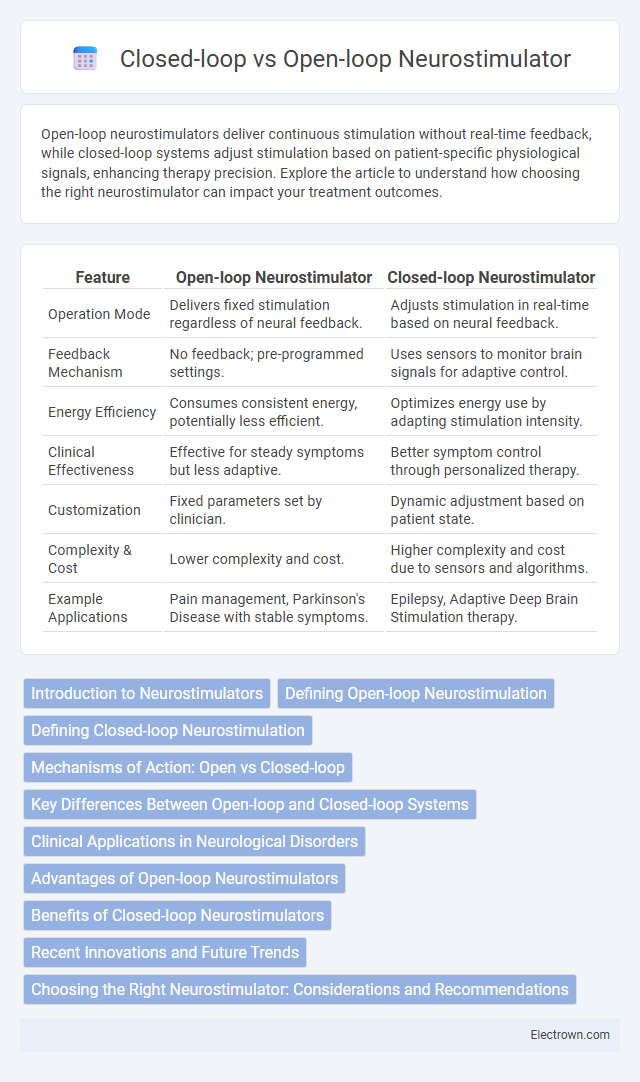Open-loop neurostimulators deliver continuous stimulation without real-time feedback, while closed-loop systems adjust stimulation based on patient-specific physiological signals, enhancing therapy precision. Explore the article to understand how choosing the right neurostimulator can impact your treatment outcomes.
Table of Comparison
| Feature | Open-loop Neurostimulator | Closed-loop Neurostimulator |
|---|---|---|
| Operation Mode | Delivers fixed stimulation regardless of neural feedback. | Adjusts stimulation in real-time based on neural feedback. |
| Feedback Mechanism | No feedback; pre-programmed settings. | Uses sensors to monitor brain signals for adaptive control. |
| Energy Efficiency | Consumes consistent energy, potentially less efficient. | Optimizes energy use by adapting stimulation intensity. |
| Clinical Effectiveness | Effective for steady symptoms but less adaptive. | Better symptom control through personalized therapy. |
| Customization | Fixed parameters set by clinician. | Dynamic adjustment based on patient state. |
| Complexity & Cost | Lower complexity and cost. | Higher complexity and cost due to sensors and algorithms. |
| Example Applications | Pain management, Parkinson's Disease with stable symptoms. | Epilepsy, Adaptive Deep Brain Stimulation therapy. |
Introduction to Neurostimulators
Neurostimulators are medical devices designed to modulate nerve activity by delivering electrical impulses to specific nervous system areas. Open-loop neurostimulators provide continuous, pre-programmed stimulation without real-time feedback, while closed-loop neurostimulators adjust stimulation dynamically based on neural signals or physiological responses. These technologies are crucial in treating neurological disorders such as Parkinson's disease, epilepsy, and chronic pain by optimizing therapeutic outcomes and minimizing side effects.
Defining Open-loop Neurostimulation
Open-loop neurostimulation involves delivering electrical impulses to specific nervous system targets without real-time feedback or adjustments based on the patient's physiological responses. This type of neurostimulator operates on pre-programmed settings, providing consistent stimulation patterns regardless of fluctuating neural activity or symptoms. Open-loop systems are commonly used in conditions like chronic pain and movement disorders where stability in stimulation parameters is sufficient for therapeutic effect.
Defining Closed-loop Neurostimulation
Closed-loop neurostimulation systems continuously monitor neural activity and adjust stimulation parameters in real time to optimize therapeutic outcomes. Unlike open-loop neurostimulators, which deliver fixed stimulation regardless of physiological feedback, closed-loop devices use sensors and algorithms to respond dynamically to changes in brain signals. This responsive approach enhances efficacy in treatments for conditions like Parkinson's disease, epilepsy, and chronic pain by providing personalized, adaptive modulation.
Mechanisms of Action: Open vs Closed-loop
Open-loop neurostimulators deliver continuous electrical pulses at preset intervals without real-time feedback, which can lead to unoptimized stimulation and variable therapeutic outcomes. Closed-loop neurostimulators monitor neural activity or physiological signals, adjusting stimulation parameters dynamically to maintain optimal efficacy and reduce side effects. Understanding these mechanisms enables you to select the appropriate neurostimulation system tailored to your specific neurological condition and treatment goals.
Key Differences Between Open-loop and Closed-loop Systems
Open-loop neurostimulators deliver pre-set stimulation patterns without real-time feedback, lacking adaptive response to neural signals. Closed-loop neurostimulators continuously monitor neural activity and adjust stimulation dynamically, enhancing precision and therapeutic effectiveness. The key differences lie in feedback utilization, adaptability, and potential for personalized treatment outcomes.
Clinical Applications in Neurological Disorders
Open-loop neurostimulators deliver constant stimulation without feedback, making them suitable for disorders like chronic pain and epilepsy where fixed parameters can manage symptoms effectively. Closed-loop neurostimulators adjust stimulation in real-time based on neural activity, offering advanced treatment for conditions such as Parkinson's disease and essential tremor by improving therapeutic outcomes and reducing side effects. Your choice between these devices should consider the specific neurological disorder and the need for adaptive, responsive therapy to optimize clinical benefits.
Advantages of Open-loop Neurostimulators
Open-loop neurostimulators provide consistent, predefined electrical stimulation without real-time feedback, ensuring straightforward operation and reduced complexity in device design. This simplicity leads to lower power consumption and longer battery life compared to closed-loop systems. You benefit from reliable symptom control with minimal need for continuous adjustments or monitoring.
Benefits of Closed-loop Neurostimulators
Closed-loop neurostimulators provide real-time feedback by continuously monitoring neural activity and adjusting stimulation parameters accordingly, leading to more precise and personalized therapy. This adaptive approach enhances treatment efficacy, reduces side effects, and conserves battery life compared to open-loop systems that deliver fixed stimulation without feedback. Clinical studies demonstrate improved symptom control and patient outcomes in conditions such as Parkinson's disease and epilepsy using closed-loop neurostimulation.
Recent Innovations and Future Trends
Recent innovations in open-loop neurostimulators include enhanced waveform customization and integration with wearable sensors for more precise stimulation control, improving patient outcomes in movement disorder therapies. Closed-loop neurostimulators have advanced through real-time neural feedback systems that adapt stimulation parameters dynamically, utilizing AI algorithms to optimize therapy for conditions like Parkinson's disease and epilepsy. Future trends point to hybrid systems combining open- and closed-loop features with cloud-based data analytics, enabling personalized, adaptive neurostimulation and remote monitoring capabilities.
Choosing the Right Neurostimulator: Considerations and Recommendations
Choosing the right neurostimulator involves evaluating patient-specific factors such as symptom variability, device adaptability, and battery life. Closed-loop neurostimulators offer real-time feedback and dynamic stimulation adjustments, enhancing therapy precision for conditions like Parkinson's disease and epilepsy, whereas open-loop systems provide continuous, preset stimulation that may suffice for stable symptom profiles. Clinicians should prioritize closed-loop devices for improved efficacy and personalized treatment but consider open-loop systems for simplicity, cost-effectiveness, and situations where feedback is less critical.
Open-loop vs Closed-loop Neurostimulator Infographic

 electrown.com
electrown.com